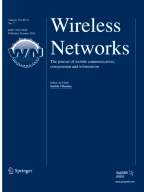Abstract
Mobile and wireless network systems are characterized by a highly time varying and heterogeneous operational environment. For example, the wireless link bandwidth and bit error rate can change due to fading, mobile nodes may have different capabilities, and in the course of its movements a mobile node may visit base stations that provide different sets of services, protocols, and interfaces. Adaptability, in various forms and at various levels of the system, is a key to combating the inherent variability of a mobile environment. This paper describes our work on Active Base Stations and Active Mobile Nodes that use the general approach of active networking to allow run-time application-specific customization of communication processing done on packets at the base station and the mobile end-nodes. This is accomplished by a software-hardware architecture that allows application specified reconfigurable hardware datapaths as well as software functions to be inserted in the path of specified packet flows at the base station and the end-node. The reconfigurable hardware datapaths as well as software functions, called Packet Processing Filters (PPF), can be uploaded or downloaded across the network, and their behavior controlled via parameter adaptation. Examples of adaptive capabilities enabled by Active Base Stations and Active Wireless Nodes include: (i) flow-specific adaptation of coding/decoding and packet lengths at the two ends of a time varying wireless link; (ii) adaptation of encryption/decryption on the wireless link according to changing locale and security environment; (iii) downloading a new or proprietary MAC protocol from a base station to visiting foreign mobiles; and (iv) dynamically uploading mobile specified services to a base station of a different service provider. We present the basic architecture and implementation approach of our system, and description of the initial software/hardware prototype.
Similar content being viewed by others
References
D.S. Alexander, M. Shaw, S.M. Nettles and J.M. Smith, Active bridging, in: Proceedings of the ACM SIGCOMM'97 Conference, Cannes, France (September 1997).
B.R. Badrinath and P. Sudame, Gathercast: The design and implementation of a programmable aggregation mechanism for the Internet, in: Proceedings of IEEE International Conference on Computer Communications and Networks (ICCCN) (October 2000).
S. Bhattacharjee, K.L. Calvert and E.W. Zergura, An architecture for active networking, in: High Performance Networking (HPN'97),White Plains, NY (April 1997).
A. Boulis, Active base stations and mobile nodes for a wireless, mobile environment, M.S. thesis, University of California, Los Angeles, Electrical Engineering Department (1999).
A. Boulis, P. Lettieri and M.B. Srivastava, Active base stations & nodes for a mobile environment, in: Proceedings of the First ACM International Workshop on Wireless Mobile Multimedia (WOWMOM'98) (October 1998) pp. 31–37.
A. Fox, S.D. Gribble, E.A. Brewer and E. Amir, Adapting to network and client variability via on-demand dynamic distillation, in: Proceedings of the Seventh International Conference on Architecture Support for Programming Languages and Operating Systems (ASPLOS-VII), Cambridge, MA (October 1996).
Gathercast, http://paul.rutgers.edu/~sudame/ gcast-dist.html
Y. Ha, P. Schaumont, L. Rijnders, S. Vernalde, F. Potargent, M. Engels and H. De Man, A scalable architecture to support networked reconfiguration, in: Proceedings of IEEE ProRISC (November 1999) pp. 677–683.
Y. Ha, P. Schaumont, M. Engels, S. Vernalde, F. Potargent, L. Rijnders and H. De Man, A hardware virtual machine to support networked reconfiguration, in: Proceedings of the 11th International Workshop on Rapid System Prototyping, Paris (June 2000) pp. 164–169.
Y. Ha, S. Vernalde, P. Schaumont, M. Engels and H. De Man, Building a virtual framework for networked reconfigurable hardware and software objects, in: Proceedings of the 2000 International Conference on Parallel and Distributed Processing Techniques and Applications, Las Vegas (June 2000) pp. 164–169.
T.D. Hodes and R.H. Katz, Composable ad hoc location-based services for heterogeneous mobile clients, Wireless Networks, Special Issue on Mobile Computing (1998).
P. Lettieri, Architectural strategies for energy-efficient wireless multimedia nodes, Ph.D. dissertation, University of California, Los Angeles, Electrical Engineering Department (2000).
P. Lettieri, C. Fragouli and M.B. Srivastava, Low power error control for wireless links, in: Proceedings of the 3rd Annual ACM/IEEE International Conference on Mobile Computing and Networking (MobiCom'97), Budapest, Hungary (26-30 September 1997) pp. 139–150.
P. Lettieri and M.B. Srivastava, Adaptive frame length control for improving wireless link throughput, range, and energy efficiency, in: Proceedings of IEEE INFOCOM'98, San Francisco, CA (29 March- 2 April 1998) pp. 564–571.
P. Lettieri and M.B. Srivastava, Advances in wireless terminals, IEEE Personal Communications (March 1999).
M. Little, A. Poylisher, A. Umar and S. Chamberlain, Aggregation networks: efficient and adaptive data acquisition for dynamic distributed environments, in: Proceedings of the Third Annual FedLab Symposium - Advanced Telecommunications & Information Distribution, US Army Research Labs (February 1999).
B. Noble, M. Price and M. Satyanarayanan, A programming interface for application-aware adaptation in mobile computing, in: Proceedings of the Second USENIX Symposium on Mobile & Location-Independent Computing, Ann Arbor, MI (April 1995).
P. Sudame and B.R. Badrinath, Transformer tunnels: A framework for providing route-specific adaptations, in: USENIX Annual Technical Conference (1998).
D.E. Taylor, J.S. Turner and J.W. Lockwood, Dynamic Hardware Plugins (DHP): Exploiting reconfigurable hardware for highperformance programmable routers, in: Proceedings of the 4th IEEE International Conference on Open Architectures and Network Programming (OPENARCH), Anchorage, AK (2001).
D. Tennenhouse and D. Wetherall, Towards an active network architecture, ACM Computer Communications Review 26(2) (April 1996) 5–18.
D. Wetherall and D. Tennenhouse, The active IP option, in: Proceedings of the 7th ACM SIGOPS European Workshop, Ireland (September 1996).
B. Zenel and D. Duchamp, A general purpose proxy filtering mechanism applied to the mobile environment, in: Proceedings of the 3rd Annual ACM/IEEE International Conference on Mobile Computing and Networking (MobiCom'97), Budapest, Hungary (26-30 September 1997) pp. 248–259.
Author information
Authors and Affiliations
Rights and permissions
About this article
Cite this article
Boulis, A., Lettieri, P. & Srivastava, M. Active Base Stations and Nodes for Wireless Networks. Wireless Networks 9, 37–49 (2003). https://doi.org/10.1023/A:1020825023234
Issue Date:
DOI: https://doi.org/10.1023/A:1020825023234
